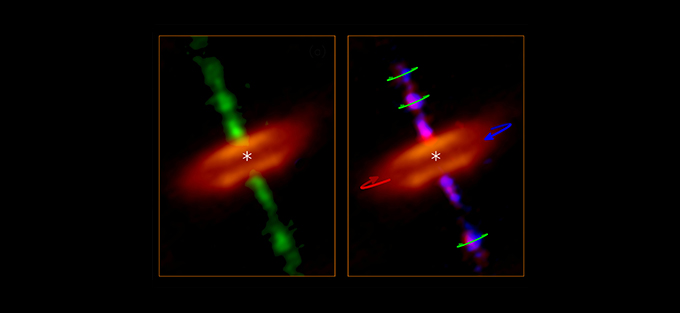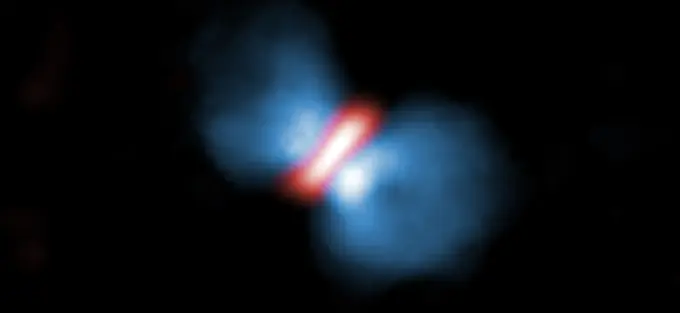Baby Star Spits a “Spinning Jet” As It Munches Down on a “Space Hamburger”
12 June, 2017 / Read time: 5 minutes
Protostellar jets are seen coming out from protostars (baby stars), representing one of the most intriguing signposts of star formation. An international research team, led by Chin-Fei Lee in Academia Sinica Institute of Astronomy and Astrophysics (ASIAA, Taiwan), has made a new breakthrough observation with the Atacama Large Millimeter/submillimeter Array (ALMA), finding a protostellar jet to be spinning, convincingly for the first time. This new result confirms the expected role of the jet in removing the excess angular momentum from the innermost region of an accretion disk (space hamburger), providing a solution to the long-standing problem of how the inner accretion disk can feed a protostar.
“We see jets coming out from most of baby stars, like a train of bullets speeding down along the rotational axis of the accretion disks. We always wonder what their role is. Are they spinning, as expected in current models of jet launching? However, since the jets are very narrow and their spinning motion is very small, we had not been able to confirm their spinning motion. Now using the ALMA with its unprecedented combination of spatial and velocity resolutions, we not only resolve a jet near a protostar down to 10 astronomical units (au) but also detect its spinning motion”, says Chin-Fei Lee at ASIAA. “It looks like a baby star spits a spinning bullet each time it takes a bite of a space hamburger.”

“The central problem in forming a star is the angular momentum in the accretion disk which prevents material from falling into the central protostar. Now with the jet carrying away the excess angular momentum from the material in the innermost region of the disk, the material can readily fall into the central protostar from the disk”, says Paul Ho at ASIAA.
HH 212 is a nearby protostellar system in Orion at about 1300 lightyears. The central protostar is very young with an age of only 40,000 years (which is about 10 millionth of the age of the Sun) and a mass of only a fifth of the Sun. Recent ALMA observations at submillimeter wavelength have detected an accretion disk feeding the central protostar. The disk is nearly edge-on and has a radius of about 60 au. Interestingly, it shows a prominent equatorial dark lane sandwiched between two brighter features, appearing as a “space hamburger”.

The central protostar drives a powerful bipolar jet. Previous observations at a spatial resolution of 140 au could not confirm a rotation for the jet. Now with ALMA at a resolution of 8 au, which is about 17 times higher, we zoom in to the innermost part of the jet down to within 10 au of the central protostar and find a jet rotation. The angular momentum is so small that the jet must be launched from the innermost region of the disk at about 0.05 au from the central protostar, well consistent with current models of the jet launching.

This new finding indicates that the jet indeed carries away part of the angular momentum (rotational momentum) from the material in the innermost region of the accretion disk (space hamburger), which is rotating around the central protostar. This reduces the rotation of the material there, allowing the disk to feed the central protostar.
These observations open an exciting possibility of detecting and measuring jet rotation around the protostars through high-resolution imaging with ALMA, which provides strong constraints on theories of jet formation in star formation. In addition, these observations also open the possibility of detecting jet rotation in other kind of objects, e.g., active nuclei of galaxies, which may play the same role of extracting disk angular momentum as the protostellar jets.
Additional information
ALMA also clearly imaged the rotation of a gas outflow from a massive protostar. (Press release "ALMA Observes Birth Cry of a Massive Baby Star").
This research was presented in a paper “A Rotating Protostellar Jet Launched from the Innermost Disk of HH 212,” by Lee et al. to appear in the journal Nature Astronomy.
The team is composed of Chin-Fei Lee (ASIAA, Taiwan; National Taiwan University, Taiwan), Paul T.P. Ho (ASIAA, Taiwan; East Asia Observatory), Zhi-Yun Li (University of Virginia, USA), Naomi Hirano (ASIAA, Taiwan), Qizhou Zhang (Harvard-Smithsonian Center for Astrophysics, USA), and Hsien Shang (ASIAA, Taiwan).
The Atacama Large Millimeter/submillimeter Array (ALMA), an international astronomy facility, is a partnership of the European Organisation for Astronomical Research in the Southern Hemisphere (ESO), the U.S. National Science Foundation (NSF) and the National Institutes of Natural Sciences (NINS) of Japan in cooperation with the Republic of Chile. ALMA is funded by ESO on behalf of its Member States, by NSF in cooperation with the National Research Council of Canada (NRC) and the Ministry of Science and Technology (MOST) in Taiwan and by NINS in cooperation with the Academia Sinica (AS) in Taiwan and the Korea Astronomy and Space Science Institute (KASI).
ALMA construction and operations are led by ESO on behalf of its Member States; by the National Radio Astronomy Observatory (NRAO), managed by Associated Universities, Inc. (AUI), on behalf of North America; and by the National Astronomical Observatory of Japan (NAOJ) on behalf of East Asia. The Joint ALMA Observatory (JAO) provides the unified leadership and management of the construction, commissioning and operation of ALMA.
Contacts
-
Dr. Chin-Fei Lee
Institute of Astrophysics and Astronomy
Academia Sinica
Phone: +886-2-2366-5445
Email: [email protected]
-
Nicolás Lira
Education and Public Outreach Coordinator
Joint ALMA Observatory, Santiago - Chile
Phone: +56 2 2467 6519
Cel: +56 9 9445 7726
Email: [email protected]
-
Masaaki Hiramatsu
Education and Public Outreach Officer, NAOJ Chile
Observatory, Tokyo - Japan
Phone: +81 422 34 3630
Email: [email protected]
-
Richard Hook
Public Information Officer, ESO
Garching bei München, Germany
Phone: +49 89 3200 6655
Cel: +49 151 1537 3591
Email: [email protected]
-
Charles E. Blue
Public Information Officer
National Radio Astronomy Observatory Charlottesville, Virginia - USA
Phone: +1 434 296 0314
Cel: +1 202 236 6324
Email: [email protected]


